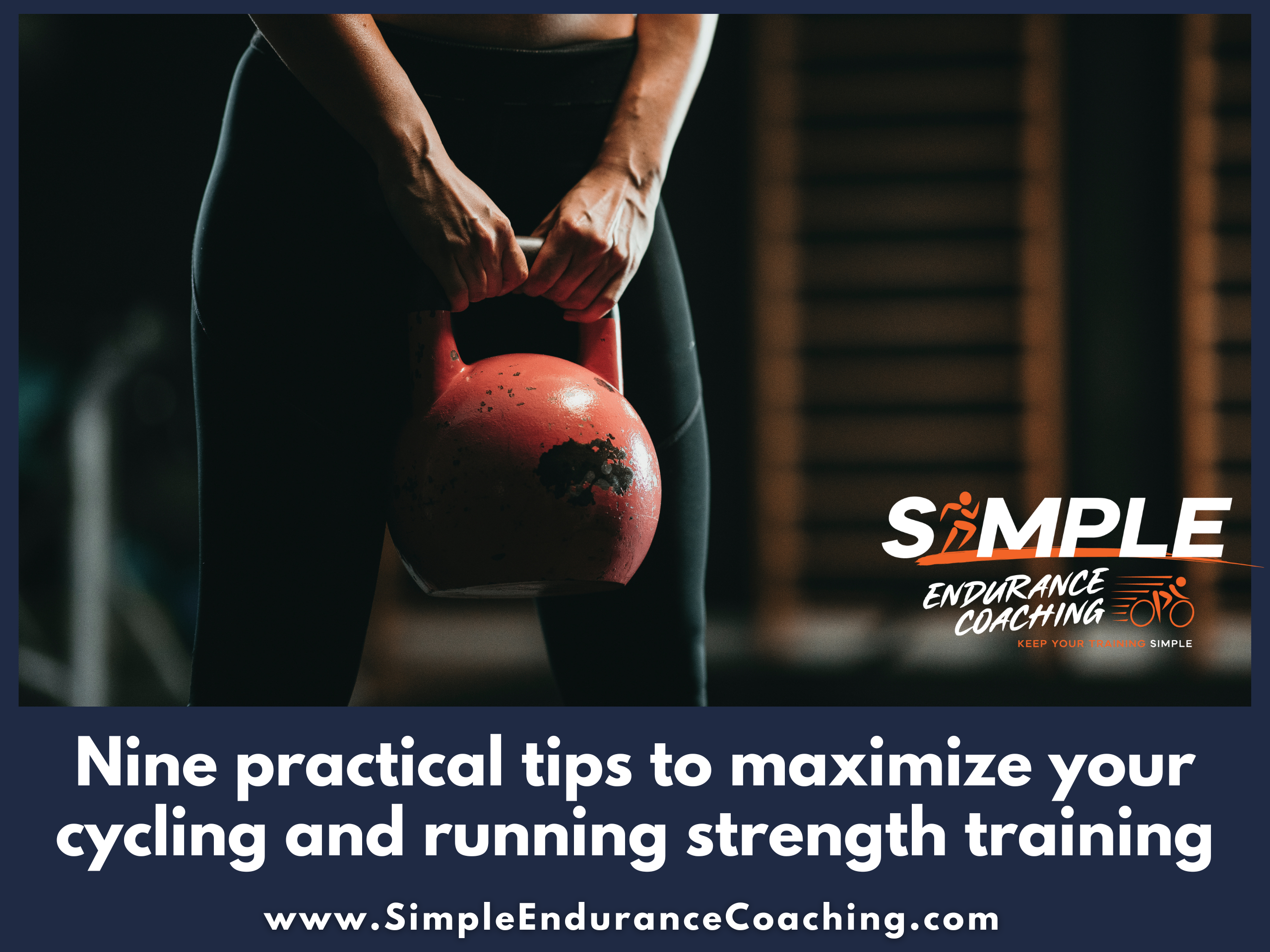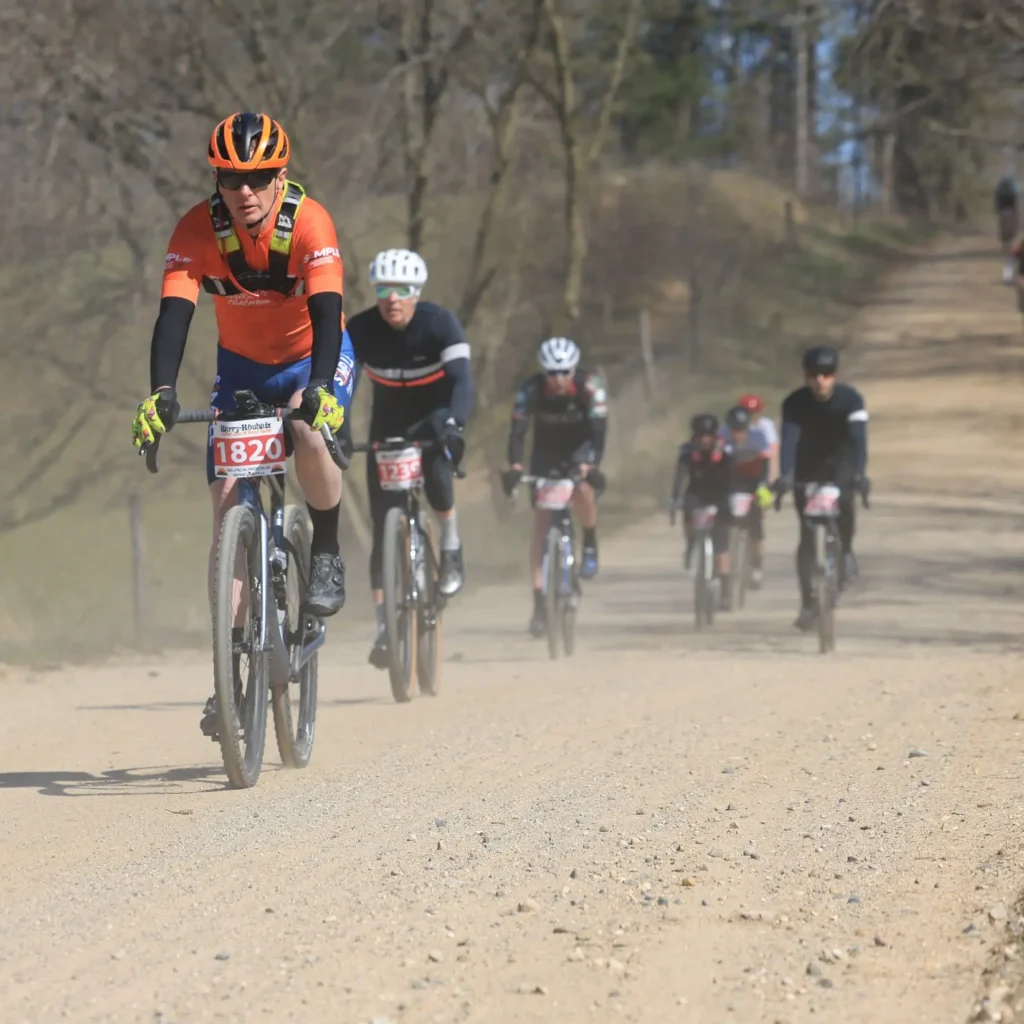Nine practical tips to maximize your cycling and running strength training
Strength training is critical for cyclists and runners, especially older riders and women.
What we’re going to dig into in this article is the specifics of how I assign strength training to my athletes.
In addition to being certified as a cycling and running coach, I’m also a certified personal trainer and started my post-teaching career working with individual strength training clients.
My background is helping people get stronger, healthier, and more fit.
Whether you’re doing gravel racing, cyclocross, trail running, or some other endurance training, we’ll help you maximize your time and efficiency while strength training.

Here’s the research:
Before we start, while I’ve written a lot about the value of strength training, I’m including several research studies just to make sure you’re convinced!
One study concludes that male and female cyclists can improve their cycling efficiency through strength training.
Here’s another study (abstract) that suggests replacing a portion of a cyclist’s ET with RT will result in improved time trial performance and maximal power.
This study (abstract) suggests adding heavy strength training improved cycling performance, increased utilization of VO2 max, and improved cycling economy.
1. Do full-body strength routines
This includes a hip hinge, chest push and pull, shoulder push and pull, and core work.
We want to train from your hips to your shoulders to create a strong core.
Doing some deadlifts or front squats will also strengthen your glutes and quads.
We also want to do some sideways lateral movement, like side lunges or Cossack squats to strengthen your gluteus medius and minimus (side butt muscles).
You don’t need to go to a gym to do a full-body strength routine.
Doing heavy deadlifts is beneficial, but you can get really strong with bodyweight exercises.
Set up a Virtual Coffee and we can talk about what you can.
2. Focus on core strength and stability
With every strength training routine, it’s critical to do core strength and stability work.
This means including planks, side planks, Hollows, and elbow plank rotations.
Please do not include sit-ups or traditional crunches in this routine.
These two exercises strengthen your rectus abominus (six-pack) muscles, which shorten them, pulling your chest and shoulders forward.
Since we’re already rolled forward from working on computers and staring at our phones, the last thing we need is more!
Activating your core is critical as well in doing the heavy deadlifts and front squats with good form.
3. Start slow and easy
When I get new athletes who haven’t done much strength training, I start them with the Back and Booty video with exercises from Foundation.
This works to strengthen back and core muscles that are foundational to strength training.
Once we dial in those movements, we start strength training in the gym.
Typically, I want cyclists and runners to be lifting heavy weights, especially for women since lifting heavy weights seems to provide a positive hormonal response.
To start with, though, we want to use lighter weights and more reps, like 10 to 12.
Eventually, we build to five to eight repetitions of each exercise so that we can maintain good form.
4. Do two sets to build fatigue
Generally, I do two sets of each exercise.
The first set is figuring out what weight I should be using that day.
I use a weight I’ve done before and do eight to 10 or so repetitions.
This first set should be fairly easy and act as a warmup.
The second set should be a weight heavy enough to do five to eight repetitions so that I’m tired by the last one.
I always want to feel like I could do two more repetitions.
So I want to build to fatigue, not failure.
The research literature says both fatigue and failure are good measures, but we are not lifting to be bodybuilders.
We just want to stress the muscles so they come back stronger.
Sometimes, I’ll do three or four sets of deadlifts simply because it takes longer for me to warm up to a heavier weight.
You can always do more if you feel like it, but most research suggests that if you build to fatigue (with only two reps left in the tank), you’ll get most of the possible gains without risking injury or overuse.
5. Lift in a circuit or superset
Depending on whether you’re at home or the gym, maximize your time by combining your lifts.
For example, do a set of deadlifts, then seated rows.
Then do a bench press with dumbbells and seated pull-downs.
It doesn’t really matter what you pair, although two push or two pull exercises can fatigue your muscles faster, which is not always optimal.
6. Progressive overload
This is a fancy term for lifting more than you usually do.
Your body gets stronger when you cause enough stress that it has to adapt to the new stress.
But if you do the same thing each time, your body gets used to the stress and doesn’t adapt anymore.
So small increases in weight are needed to continue getting stronger.
Likewise, changing up the exercises you do forces your body to adapt in new ways.
For example, if you do dumbbell chest presses for four weeks, change to pushups for the next four weeks, then do chest presses on the TRX.
This provides enough variation so that your body continually adapts and gets stronger.
7. Recover to get stronger
As soon as I’m done with a strength training session, I gulp down a protein drink to begin the recovery process.
I also use some creatine to help build additional muscle in my old man’s body.
I want my athletes to get good sleep and take rest days after strength training to allow for rebuilding the muscle.
Yoga can also be a great way to both recover from strength training or use your body weight to get stronger.
Remember, strength doesn’t happen in the gym, it happens when you sleep and rest.
8. Be consistent with your training
Since our training is primarily cycling or running, that’s where we want to spend the majority of our time.
So I limit strength training to two or three days a week, spaced out every other day.
For example, in the pre-season, we might lift Monday, Wednesday, and Friday.
During the season, we’ll lift one or two days a week, depending on how close we are to racing.
We don’t schedule strength the week of A races, but we do on B and C races.
Again, we’re looking to do short, heavy sessions.
9. Generally, make your hard days hard
There are a lot of ways to schedule your strength training.
And there’s some new research that suggests that lifting heavy before doing intervals can prime the muscles for better performance.
But that may mean doing your intervals immediately after lifting.
The jury is still out on that.
I typically schedule strength in one of two ways:
- Do either strength or intervals in the morning, then the other in the evening, OR
- Do the strength training after intervals.
Doing strength and intervals on the same day means you get one hard day and can take the next day as an endurance or rest day.
Sometimes schedules don’t work out, and strength happens on an endurance day.
There doesn’t seem to be much difference whether you do strength or endurance first.
Three things to know about strength training for cyclists and runners:
- It works. Get in the gym or use your home equipment
- Lift to fatigue, not failure
- Slowly increase the weight you’re lifting.
Need more?
GET A FREE Core Strength and Stability training video when you opt in to receive my weekly blog posts about what works in endurance sports.
SIGN UP FOR A Virtual Coffee so we can discuss your goals, ask questions, and talk about making your endurance training more effective, fun, and Simple.
I can help you structure an individualized strength training plan. Set up a Coffee and let’s talk.
Paul Warloski is a:
- USA Cycling Level 2 Coach
- RRCA Running Coach
- Training Peaks Level 2 Coach
- RYT-200 Yoga Instructor
- Certified Personal Trainer




